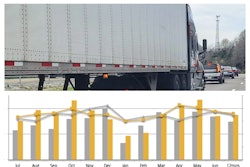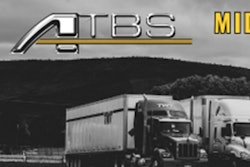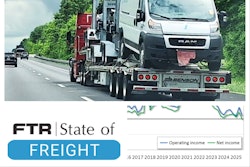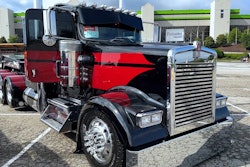All owner-operators want to know the answer to the same question before taking a load -- is this run actually going to make me money?
After delivery, a variation on the same question too often goes un-asked: Did the load actually bring a profit when all the costs are considered?
In the video up top, longtime Overdrive contributor and trucking-biz coach Gary Buchs and I walk you through a shorter version, with illustrations, of the conversation we had on Overdrive Radio back in August, a tutorial on ways to use Overdrive's Load Profit Analyzer calculator tool. In the video you'll find plenty options for assessing costs not only in relation to miles but valuable time, too.
Likewise comparisons of three different load examples an owner-op's presented with sitting one fine morning near Dallas, Texas, and mulling options for the next couple days:
- Load 1: Dallas to Chicago, ready now for pickup -- 950 loaded miles. Days budgeted: Conservatively, 2. Offer rate: $2,185.
- Load 2: Dallas to Nashville, Tennessee, not ready for pick until late in the afternoon -- 650 loaded miles. Days budgeted: 2. Offer rate: $2,100.
- Load 3: Local move, also not ready for pick until late afternoon -- 80 loaded miles. Days budgeted: 1. Offer rate: $800.
[Related: $2.30, $3, $10/mile: Which load would you choose? Profit analysis might surprise you]
Overdrive's Load Profit Analyzer was in part inspired by profit analysis Gary Buchs himself developed and used for his own owner-operator business throughout a long career. In the video, we aim to show you how to apply that analysis yourself via the fairly simple Analyzer tool not only to help with load choice.
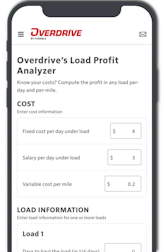
As Buchs emphasizes, it might also be the self-accountability tool for analysis of your actual performance. "After you run a load and you've run this estimate" of profit potential for a load offer, he said, take time to consider the actual time put into the load, and real numbers for variable costs incurred and revenue procured. "And check yourself, to see how close you came" to the front-end estimate. As time goes on and you repeat the process, it "will help you tremendously [to] build your confidence in your decisions."
[Related: Calculate any load's cost in relation to time, not just miles]
Find the more expansive version of Buchs' tutorial in the following Overdrive Radio edition, with which you can follow along with the Analyzer itself at this link.
In this video:
00:00 – Free Load Profitability Calculator
00:51 – Accessing the Calculator
01:30 – Fixed Cost per Day
02:48 – Salary per Day
03:35 – Variable Cost per Mile
04:36 – Load 1 Calculation
05:38 – Load 2
06:19 – Calculation and Comparison
08:34 – Load 3
09:54 – More Accuracy
Todd Dills: Any independent owner operator asked the same question before taking a load. Is this run actually going to make me money after delivery? It's a variation on the same question. Did the load actually bring a profit when all the costs are considered? I'm Todd Dills, chief editor, Overdrive magazine. We've been delivering owner operators, news and business advice for more than 60 years, and today we're going to walk you through a new tool that we hope will help, you know, if a load is truly profitable before you ever take it.
Likewise, evaluate the true profit level after you do. To show you how it works. You'll hear a conversation between me and Gary Buchs, trucking business coach, Overdrive contributor and past longtime owner operator. This load profit calculator was in part inspired by profit analysis Gary developed and used throughout his career. And in this video, we'll show you exactly how to put it to work.
You start by going to overdriveonline.com/load-analyzer. At the top you'll see three cost fields fixed cost per day, salary per day, and variable cost per mile. These are the foundation of your profit calculation. If you're used to only looking at total cost per mile, you can still use the tool that way. Simply set fixed cost and salary to zero, then enter your total cost per mile under variable costs.
But for more accurate results, more meaningful results really, break your cost into three categories. First, we'll go over some advice on how to arrive at each of these numbers.
Gary Buchs: Think of that number as if you take the week off or the month off. What are the things you still have to pay for? And that would include the truck payment, the insurances, another loan payment. You know, services that you're paying for, subscriptions that you have to pay for, and so on.
Todd Dills: What is the figure that we're going to use for this calculation? And, and where did it come from?
Gary Buchs:I made a determination to just use $300 a day as an average, just a starting point for us to keep it a little bit simple.
Todd Dills: In this case, the $300 figure Buchs based on a calculation of annual fixed costs for an owner operator divided by a conservative 200 days worked in a calendar year.
That's a fairly conservative estimate of the number of days work for an owner operator. If an actual owner operator is coming to this number themselves, a good way to do it. Look at your fixed cost for the prior year or whatever the term is, right, or month prior to months, and divide that number by the number of days that you actually worked.
Gary Buchs: But whatever you decide to use, just consistently keep it the same. And that will be your baseline. And that'll help you as you make judgment calls on loads.
Todd Dills: Salary per day. What's the figure that we're going to use for this. And I guess it's it's based a little bit on some, some of the people that you work with.
Gary Buchs: Whatever number you need to cover your home expenses, whether you pay yourself a salary or not. I would use that number divided by the number of days you use for fixed use, the same number of days divide that home need and come up with a number. So that's going to vary far more than the fixed cost.
Todd Dills: Because everybody has different home obligations, house payments, rent. You know, whether or not the spouse is working that sort of thing. So there's a whole lot of variation there. But we're going with $300 per day. Variable cost per mile is things that you pay for while you're running the truck. So we're talking fuel.
We're talking cost for parts, tires, maintenance. Et cetera. What's the figure that we're going to use for this calculation? And how do we arrive that year?
Gary Buchs: When I looked at the records, it can vary quite a bit between, you know, owners, I would say. Right now that would be a between 95 and a dollar, five a mile in most cases of this is cash based. And there's a good chance that near 50% of that is going to be fuel, depending on your truck fuel efficiency.
And so each of you will have a different number. So this will require you knowing the miles that you ran for. I would use a monthly average for for mile 98 five number. I think especially someone with a newer truck, who doesn't have a big repair bill, has a warranty.
Todd Dills: With their costs in place, we'll look at three possible loads from Dallas and run them through the calculator to find out which brings in the most profit. Keep an eye on the third load, because it shows how a longer haul may not always be the right choice.
The first load is a load out of the Dallas region, up toward the Midwest, and Chicago and the owner is aware that there's going to be some potential for delay time at each of those facilities. So he's thinking fairly conservatively in budgeting in at least a couple of days for this run, even though it is, it could it could fall into, more of a one and a half to one and three quarter days kind of time frame. Just given the length of it.
He knows he's got about 60 deadhead miles. This is 950 loaded miles. The calculator automatically adds the two for your total miles figure. And then the gross rate offered on the load is $2,185. This one is ready for pickup whenever he is available to do it. Right then in there in the morning in the calculator.
What you see when you start adding information here is, an option for a second load will come up down here. The second load is going a shorter distance to Nashville, Tennessee area that's 650 miles. He's still budgeting in two days for it, though, however, because it's not going to be available for pickup until the afternoon of that day.
Am I doing this right, Gary? And getting into two days because he knows he's going to have to sit there and wait.
Gary Buchs: You want to be consistent with when you start or stop your time. I would say that is correct.
Todd Dills: The rate is close to the rate of the longer load. But we're going to calculate the results and see what we get on the other end. And we'll talk about that.
In the load analyzer, just tap or click the Calculate Results button. And what you'll see will be tabs for each load with results for the first one here to Chicago. That's total cost to haul the load at $2,189.80. Then total cost per mile for all miles is $2.17. Potential profit then to the business is actually a cost at a -$4.80 for profit per mile, and exactly zero results also show the profit plus salary.
Adding back in $300 per day of salary shows $595.20 for the owner operator in the bank, but not meeting that $300 per day home need over the two days expected to haul the load.
Gary Buchs: But if you were hiring a driver to drive for you, you would be absorbing the -$4.80. You're going to actually have to pay your driver another $4.80 above the revenue you've received, is what it comes down to. So if you're driving for yourself, are you going to value yourself less than an employee? This is part of the mindset of an owner.
You have to be careful not to overly rationalize. It doesn't mean that that won't be the right load in. In any situation, you sometimes have to look at the bigger picture as well.
Todd Dills: So load two just for comparison's sake. Total cost to haul the load is less.
A grand total of $1,866.40, but with fewer miles, the run to Nashville has a higher cost per mile at $2.74 for all miles. Still, though, we’ve got $233 and a potential profit per mile of $0.34. And that's that's, with the salary included on the cost says add the salary. Back then we're looking at, you know, fairly decent $833 and profit plus salary per day, looking at about $416. So not a bad not a bad choice here. Probably, you know, if you're if you're choosing between these two loads, this is the probably the one you want to take.
Gary Buchs: It's better.
Todd Dills: Let's give our, our hypothetical owner operator sitting in Dallas the third option. Let's keep him right there in the Dallas region. And, this is the load that, again, like the Nashville load is not going to be available until later in the day for moving. Sitting there in the morning, we'll be conservative in and say, we'll give him a day to do it.
Gary Buchs: You want to play as you don't want to underestimate and cheat yourself. Yeah.
Todd Dills: It's got 25 miles a deadhead, so less than both of the others to it is a grand total of 80 miles, for a total of 105 miles worth of a load. The gross rate on this is a flat 800 bucks.
Now calculate results. Total cost. The whole. The load sits at $702.90, or $6.69 per mile, at a single full day's worth of time and load. Potential profit over and above salaries $97.10, with an extra 300 in the profit plus salary. Figure.
What the third load really shows us is that more miles don't always mean more profit, sometimes shorter runs, when you factor in costs in relation to time spent under the load. Sometimes that shorter run might be the smarter choice. Understanding all your costs and how they relate to both distance and time is key to making best decision to close.
Here's one more piece of advice on how to make this calculator even more helpful over the long term, with analysis of your actual performance.
Gary Buchs: And so the last thing would be after you run a load and you've run this estimate for doing the contract, go back, take the actual time and real numbers of course, and check yourself and see how close you came. That will really help you tremendously and build your confidence in your decision.
Todd Dills: Big thanks to Gary Buchs for walking us through it all with overdrive to load Profit Analyzer, and I hope you'll use it as best you can find it at overdriveonline.com/load-analyzer.

